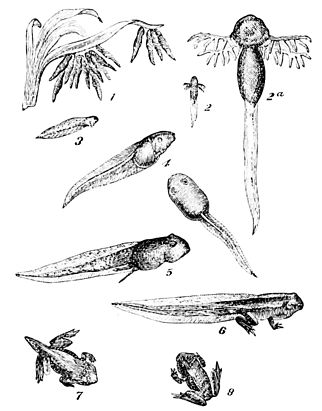may be, free air is so essential to many fishes that they die if prevented from obtaining it, especially in hot weather.
There is no organic reason why fishes could not breathe air if the gills could be kept moist and free. Indeed, there are a few fishes which even pass a great part of their lives out of water. "Such are the two genera, both belonging to the Gobiidœ, Periopthalmus and Boleopthalmus; these skip along close to the water-line on the sea-shore, where they hunt for mollusks and insects. In their branchial

Fig. 3.—Eight Stages of the Development of the Tadpole, from the recently hatched (1) to the Adult Form (8).
cavity; like all fishes, they have true gills; but these, though not differing widely from those of other fishes living constantly in the water, are far from filling up the cavity, which is rather large; and this seems to contain not merely water but air as well."[1] It will be seen that this respiration is analogous to that of the land-crabs. And no better illustration is needed to show the identity in principle of the two kinds of respiration, aquatic and aërial.
Another class of air-breathing fishes, of which the Anabas scandens, or climbing perch of India, is a famous example, have an upward extension of the branchial cavity containing complicated foldings of the skull-bones covered with mucous membrane, which remains moist either by secretion or by condensation of moisture from the air. The Anabas lives in ponds which are liable in times of severe drought to
- ↑ Karl Semper's "Animal Life," p. 189.
